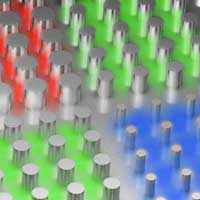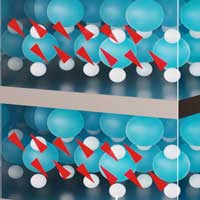|
Nanotechnology News from Nanowerk
&uuid=(email))
 By expanding on existing designs for electrodes of ultra-thin solar panels, researchers have developed a new architecture for OLED - organic light-emitting diode - displays that could enable televisions, smartphones and virtual or augmented reality devices with resolutions of up to 10,000 pixels per inch (PPI). 
 Scientists have discovered a way to control the growth of twisting, microscopic spirals of materials just one atom thick. 
 Researchers have developed a first-of-its-kind catalyst that is able to process polyolefin plastics such as polyethylene and polypropylene, types of polymers widely used in things like plastic grocery bags, milk jugs, shampoo bottles, toys, and food containers. 
 Effects at the interface between magnetic and non-magnetic layers have been exploited for data storage for three decades. This has led to a steady increase in hard drive storage capacity and is one reason why researchers see potential for ushering data processing into a new era. 
 A multidisciplinary group that studies the physical and chemical properties of insect wings has demonstrated the ability to reproduce the nanostructures that help cicada wings repel water and prevent bacteria from establishing on the surface. 
 A new study comprehensively reviews the magnetic structure of the multiferroic material bismuth ferrite. 
 Researchers have developed a nanofiber membrane that can be sandwiched between the cloth pieces in a homemade mask. These nanofibers make regular cloth masks as strong as N95 masks. 
Being able to replicate the extraordinary mechanical properties of nacre and other biological structures could lead to synthetic materials that possess the exceptional mechanical properties required to perform under extreme conditions. In this context, ultrahigh molecular weight polyethylene is a high-performance specialty polymer with a unique set of properties and applications. It shows remarkable strength-to-weight ratio and an excellent energy absorption ability, making it a promising material for protective applications such as body armor, biomedical implants or heat-resistant coatings. 
 Novel technique visualizes individual atoms in a protein with cryo electron microscopy for the first time. 
 A new review summarizes the developments in the emerging field of loose nanofiltration, and provides guidance to improve the fabrication of loose nanofiltration membranes and facilitate their applications in resource recovery. 
 Researchers succeeded in developing a material that works like a luminescent solar concentrator and can even be applied to textiles. This opens up numerous possibilities for producing energy directly where it is needed, i.e. in the use of everyday electronics. 
 Researchers have identified how oxygen affects the synthesis of a novel MOF. 
|
|